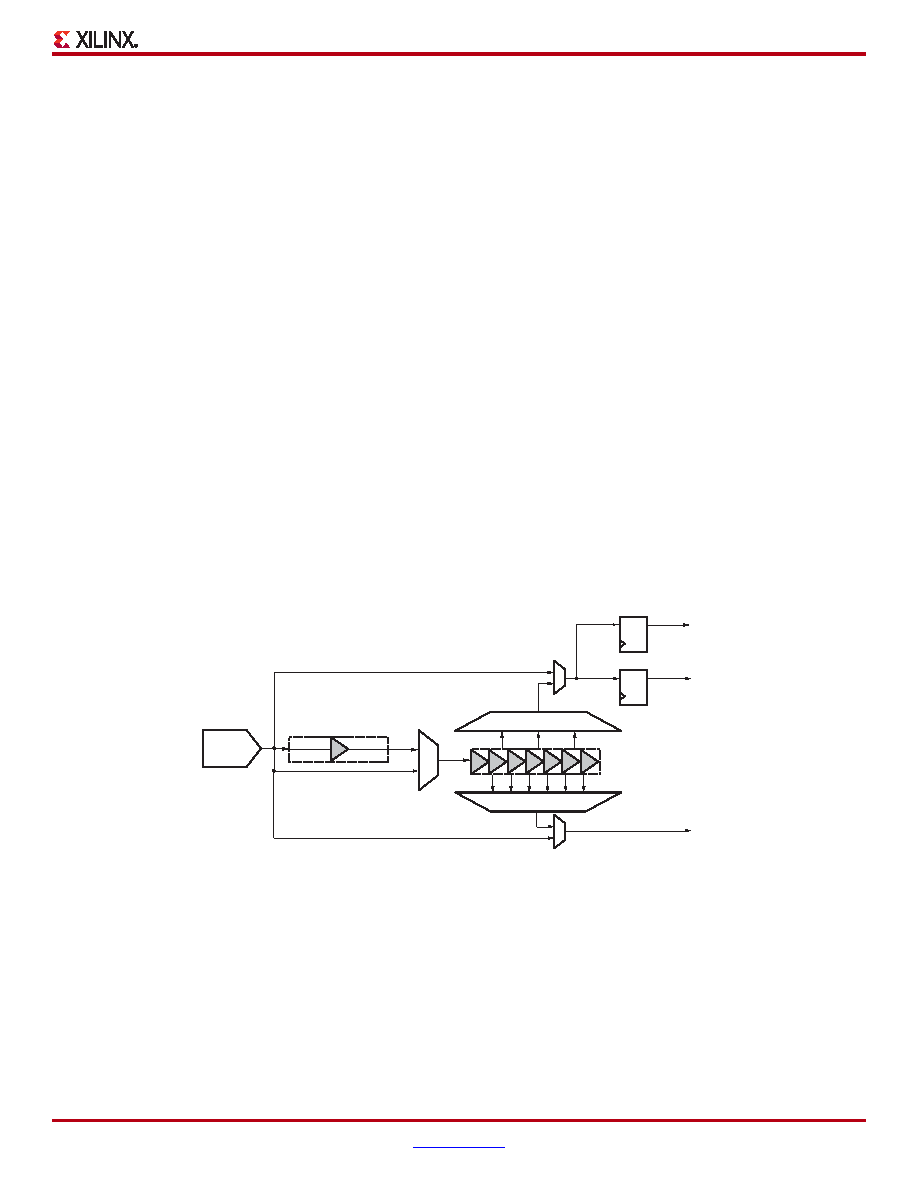- 您現(xiàn)在的位置:買賣IC網(wǎng) > PDF目錄1973 > XC3S1600E-5FGG484C (Xilinx Inc)IC FPGA SPARTAN-3E 1600K 484FBGA PDF資料下載
參數(shù)資料
| 型號: | XC3S1600E-5FGG484C |
| 廠商: | Xilinx Inc |
| 文件頁數(shù): | 24/227頁 |
| 文件大?。?/td> | 0K |
| 描述: | IC FPGA SPARTAN-3E 1600K 484FBGA |
| 標(biāo)準(zhǔn)包裝: | 60 |
| 系列: | Spartan®-3E |
| LAB/CLB數(shù): | 3688 |
| 邏輯元件/單元數(shù): | 33192 |
| RAM 位總計: | 663552 |
| 輸入/輸出數(shù): | 376 |
| 門數(shù): | 1600000 |
| 電源電壓: | 1.14 V ~ 1.26 V |
| 安裝類型: | 表面貼裝 |
| 工作溫度: | 0°C ~ 85°C |
| 封裝/外殼: | 484-BBGA |
| 供應(yīng)商設(shè)備封裝: | 484-FBGA |
| 配用: | HW-XA3S1600E-UNI-G-ND - KIT DEVELOPMENT AUTOMOTIVE ECU |
第1頁第2頁第3頁第4頁第5頁第6頁第7頁第8頁第9頁第10頁第11頁第12頁第13頁第14頁第15頁第16頁第17頁第18頁第19頁第20頁第21頁第22頁第23頁當(dāng)前第24頁第25頁第26頁第27頁第28頁第29頁第30頁第31頁第32頁第33頁第34頁第35頁第36頁第37頁第38頁第39頁第40頁第41頁第42頁第43頁第44頁第45頁第46頁第47頁第48頁第49頁第50頁第51頁第52頁第53頁第54頁第55頁第56頁第57頁第58頁第59頁第60頁第61頁第62頁第63頁第64頁第65頁第66頁第67頁第68頁第69頁第70頁第71頁第72頁第73頁第74頁第75頁第76頁第77頁第78頁第79頁第80頁第81頁第82頁第83頁第84頁第85頁第86頁第87頁第88頁第89頁第90頁第91頁第92頁第93頁第94頁第95頁第96頁第97頁第98頁第99頁第100頁第101頁第102頁第103頁第104頁第105頁第106頁第107頁第108頁第109頁第110頁第111頁第112頁第113頁第114頁第115頁第116頁第117頁第118頁第119頁第120頁第121頁第122頁第123頁第124頁第125頁第126頁第127頁第128頁第129頁第130頁第131頁第132頁第133頁第134頁第135頁第136頁第137頁第138頁第139頁第140頁第141頁第142頁第143頁第144頁第145頁第146頁第147頁第148頁第149頁第150頁第151頁第152頁第153頁第154頁第155頁第156頁第157頁第158頁第159頁第160頁第161頁第162頁第163頁第164頁第165頁第166頁第167頁第168頁第169頁第170頁第171頁第172頁第173頁第174頁第175頁第176頁第177頁第178頁第179頁第180頁第181頁第182頁第183頁第184頁第185頁第186頁第187頁第188頁第189頁第190頁第191頁第192頁第193頁第194頁第195頁第196頁第197頁第198頁第199頁第200頁第201頁第202頁第203頁第204頁第205頁第206頁第207頁第208頁第209頁第210頁第211頁第212頁第213頁第214頁第215頁第216頁第217頁第218頁第219頁第220頁第221頁第222頁第223頁第224頁第225頁第226頁第227頁

Spartan-3E FPGA Family: Functional Description
DS312 (v4.1) July 19, 2013
Product Specification
12
Input Delay Functions
Each IOB has a programmable delay block that optionally
delays the input signal. In Figure 6, the signal path has a
coarse delay element that can be bypassed. The input
signal then feeds a 6-tap delay line. The coarse and tap
delays vary; refer to timing reports for specific delay values.
All six taps are available via a multiplexer for use as an
asynchronous input directly into the FPGA fabric. In this
way, the delay is programmable in 12 steps. Three of the six
taps are also available via a multiplexer to the D inputs of
the synchronous storage elements. The delay inserted in
the path to the storage element can be varied in six steps.
The first, coarse delay element is common to both
asynchronous and synchronous paths, and must be either
used or not used for both paths.
The delay values are set up in the silicon once at
configuration time—they are non-modifiable in device
operation.
The primary use for the input delay element is to adjust the
input delay path to ensure that there is no hold time
requirement when using the input flip-flop(s) with a global
clock. The default value is chosen automatically by the
Xilinx software tools as the value depends on device size
and the specific device edge where the flip-flop resides. The
value set by the Xilinx ISE software is indicated in the Map
report generated by the implementation tools, and the
resulting effects on input timing are reported using the
Timing Analyzer tool.
If the design uses a DCM in the clock path, then the delay
element can be safely set to zero because the
Delay-Locked Loop (DLL) compensation automatically
ensures that there is still no input hold time requirement.
Both asynchronous and synchronous values can be
modified, which is useful where extra delay is required on
clock or data inputs, for example, in interfaces to various
types of RAM.
These delay values are defined through the
IBUF_DELAY_VALUE and the IFD_DELAY_VALUE
parameters. The default IBUF_DELAY_VALUE is 0,
bypassing the delay elements for the asynchronous input.
The user can set this parameter to 0-12. The default
IFD_DELAY_VALUE is AUTO. IBUF_DELAY_VALUE and
IFD_DELAY_VALUE are independent for each input. If the
same input pin uses both registered and non-registered
input paths, both parameters can be used, but they must
both be in the same half of the total delay (both either
bypassing or using the coarse delay element).
X-Ref Target - Figure 6
Figure 6: Programmable Fixed Input Delay Elements
PAD
Asynchronous input (I)
Synchronous input (IQ2)
Synchronous input (IQ1)
DQ
UG331_c10_09_011508
Coarse Delay
IBUF_DELAY_VALUE
IFD_DELAY_VALUE
相關(guān)PDF資料 |
PDF描述 |
|---|---|
| XC3S400AN-4FG400I | IC FPGA SPARTAN 3AN 400FBGA |
| XC3SD1800A-4CSG484LI | IC FPGA SPARTAN 3 DSP 484CSGBGA |
| XC3SD3400A-4FGG676I | SPARTAN-3ADSP FPGA 3400K 676FBGA |
| XC4036XLA-09HQ240C | IC FPGA C 2.5V 288 I/O 240HQFP |
| XC4062XL-09HQ240C | IC FPGA C-TEMP 3.3V 240-HQFP |
相關(guān)代理商/技術(shù)參數(shù) |
參數(shù)描述 |
|---|---|
| XC3S1600E-5FGG484I | 制造商:XILINX 制造商全稱:XILINX 功能描述:Spartan-3E FPGA Family |
| XC3S1600E-5FT256C | 制造商:XILINX 制造商全稱:XILINX 功能描述:Spartan-3E FPGA Family |
| XC3S1600E-5FT256I | 制造商:XILINX 制造商全稱:XILINX 功能描述:Spartan-3E FPGA Family |
| XC3S1600E-5FTG256C | 制造商:XILINX 制造商全稱:XILINX 功能描述:Spartan-3E FPGA Family |
| XC3S1600E-5FTG256I | 制造商:XILINX 制造商全稱:XILINX 功能描述:Spartan-3E FPGA Family |
發(fā)布緊急采購,3分鐘左右您將得到回復(fù)。